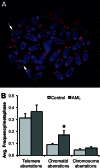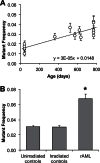Molecular characterisation of murine acute myeloid leukaemia induced by 56Fe ion and 137Cs gamma ray irradiation
- PMID: 22987027
- PMCID: PMC3716295
- DOI: 10.1093/mutage/ges055
Molecular characterisation of murine acute myeloid leukaemia induced by 56Fe ion and 137Cs gamma ray irradiation
Abstract
Exposure to sparsely ionising gamma- or X-ray irradiation is known to increase the risk of leukaemia in humans. However, heavy ion radiotherapy and extended space exploration will expose humans to densely ionising high linear energy transfer (LET) radiation for which there is currently no understanding of leukaemia risk. Murine models have implicated chromosomal deletion that includes the hematopoietic transcription factor gene, PU.1 (Sfpi1), and point mutation of the second PU.1 allele as the primary cause of low-LET radiation-induced murine acute myeloid leukaemia (rAML). Using array comparative genomic hybridisation, fluorescence in situ hybridisation and high resolution melt analysis, we have confirmed that biallelic PU.1 mutations are common in low-LET rAML, occurring in 88% of samples. Biallelic PU.1 mutations were also detected in the majority of high-LET rAML samples. Microsatellite instability was identified in 42% of all rAML samples, and 89% of samples carried increased microsatellite mutant frequencies at the single-cell level, indicative of ongoing instability. Instability was also observed cytogenetically as a 2-fold increase in chromatid-type aberrations. These data highlight the similarities in molecular characteristics of high-LET and low-LET rAML and confirm the presence of ongoing chromosomal and microsatellite instability in murine rAML.
Figures




Similar articles
-
PU.1 downregulation in murine radiation-induced acute myeloid leukaemia (AML): from molecular mechanism to human AML.Carcinogenesis. 2015 Apr;36(4):413-9. doi: 10.1093/carcin/bgv016. Epub 2015 Mar 6. Carcinogenesis. 2015. PMID: 25750172 Free PMC article. Review.
-
Influence of radiation quality on mouse chromosome 2 deletions in radiation-induced acute myeloid leukaemia.Mutat Res Genet Toxicol Environ Mutagen. 2015 Nov;793:48-54. doi: 10.1016/j.mrgentox.2015.07.012. Epub 2015 Jul 28. Mutat Res Genet Toxicol Environ Mutagen. 2015. PMID: 26520372
-
Live cell detection of chromosome 2 deletion and Sfpi1/PU1 loss in radiation-induced mouse acute myeloid leukaemia.Leuk Res. 2013 Oct;37(10):1374-82. doi: 10.1016/j.leukres.2013.05.019. Epub 2013 Jun 25. Leuk Res. 2013. PMID: 23806234 Free PMC article.
-
Dose-Rate-Dependent PU.1 Inactivation to Develop Acute Myeloid Leukemia in Mice Through Persistent Stem Cell Proliferation After Acute or Chronic Gamma Irradiation.Radiat Res. 2019 Dec;192(6):612-620. doi: 10.1667/RR15359.1. Epub 2019 Sep 27. Radiat Res. 2019. PMID: 31560640
-
G2 chromatid damage and repair kinetics in normal human fibroblast cells exposed to low- or high-LET radiation.Cytogenet Genome Res. 2004;104(1-4):211-5. doi: 10.1159/000077491. Cytogenet Genome Res. 2004. PMID: 15162040 Review.
Cited by
-
MMR Deficiency Does Not Sensitize or Compromise the Function of Hematopoietic Stem Cells to Low and High LET Radiation.Stem Cells Transl Med. 2018 Jul;7(7):513-520. doi: 10.1002/sctm.17-0295. Epub 2018 Apr 14. Stem Cells Transl Med. 2018. PMID: 29656536 Free PMC article.
-
In vitro and in vivo assessment of direct effects of simulated solar and galactic cosmic radiation on human hematopoietic stem/progenitor cells.Leukemia. 2017 Jun;31(6):1398-1407. doi: 10.1038/leu.2016.344. Epub 2016 Nov 24. Leukemia. 2017. PMID: 27881872 Free PMC article.
-
Oxidative Stress and X-ray Exposure Levels-Dependent Survival and Metabolic Changes in Murine HSPCs.Antioxidants (Basel). 2021 Dec 22;11(1):11. doi: 10.3390/antiox11010011. Antioxidants (Basel). 2021. PMID: 35052515 Free PMC article.
-
PU.1 downregulation in murine radiation-induced acute myeloid leukaemia (AML): from molecular mechanism to human AML.Carcinogenesis. 2015 Apr;36(4):413-9. doi: 10.1093/carcin/bgv016. Epub 2015 Mar 6. Carcinogenesis. 2015. PMID: 25750172 Free PMC article. Review.
-
Exposure to low-dose (56)Fe-ion radiation induces long-term epigenetic alterations in mouse bone marrow hematopoietic progenitor and stem cells.Radiat Res. 2014 Jul;182(1):92-101. doi: 10.1667/RR13580.1. Epub 2014 Jun 24. Radiat Res. 2014. PMID: 24960414 Free PMC article.
References
-
- Shimizu Y., Kato H., Schull W. J. (1991). Risk of cancer among atomic bomb survivors. J. Radiat. Res 32 Suppl 2, 54–63 - PubMed
-
- Cardis E., Gilbert E. S., Carpenter L., et al. (1995). Effects of low doses and low dose rates of external ionizing radiation: cancer mortality among nuclear industry workers in three countries. Radiat. Res 142, 117–132 - PubMed
-
- Wright J. D., St Clair C. M., Deutsch I., Burke W. M., Gorrochurn P., Sun X., Herzog T. J. (2010). Pelvic radiotherapy and the risk of secondary leukemia and multiple myeloma. Cancer 116, 2486–2492 - PubMed
-
- Travis L. B., Andersson M., Gospodarowicz M., et al. (2000). Treatment-associated leukemia following testicular cancer. J. Natl Cancer Inst 92, 1165–1171 - PubMed
-
- Smith S. M., Le Beau M. M., Huo D., Karrison T., Sobecks R. M., Anastasi J., Vardiman J. W., Rowley J. D., Larson R. A. (2003). Clinical-cytogenetic associations in 306 patients with therapy-related myelodysplasia and myeloid leukemia: the University of Chicago series. Blood 102, 43–52 - PubMed
Publication types
MeSH terms
Substances
Grants and funding
LinkOut - more resources
Full Text Sources
Medical
Molecular Biology Databases

